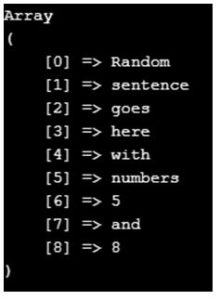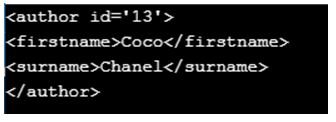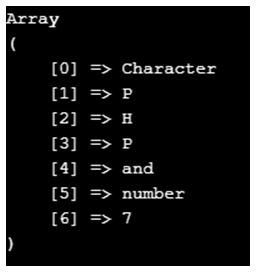The sscanf() is a pre-defined function in PHP which returns parsed input string after parsing it as per the required format. It takes the input of 2 parameters and gives us the required array and in other case when other parameters are passed such as optional ones, the data parsed will be stored in them. It throws an error when there are more specifiers than the variables to contain these and the extra variables will get NULL if there are lower specifiers present than the variables.
Start Your Free Software Development Course
Web development, programming languages, Software testing & others
Syntax of PHP sscanf()
Given below is the syntax of PHP sscanf():
sscanf(input_string, format, arg1, arg2, arg3....)
Input Parameters:
1. input_string: This is the input string to be read.
2. format:?We can specify the formats as per the below list as required:
- %%: This format will be in percent sign.
- %c: This format returns the character as per the ASCII values required.
- %d: This format is for signed decimal value. (Can be zero, negative or positive)
- %e: This format returns scientific notation in lower case. (e.g. 1.2e+2)
- %u: Used for representing unsigned decimal number which is either equal to or greater than zero.
- %f: This is used to represent a floating point number.
- %o: This is used to represent an octal number.
- %s: This represents string format.
- %x: This represent lower case letters for a hexadecimal number.
- %X: This represent uppercase letters for a hexadecimal number.
There are also a few additional format values which are placed between the % symbol and the letter we give. (For example %0.3f)
- + (This forces both + and – values in the beginning of numbers and there are only negative values marked by default).
- ‘ (This describes as to what to be used as a padding and space is the default value here. This should be used along with the width specifier. For example: %x30s which uses x for padding).
- – (This on the left will give us the variable value).
- [0-9] (This gives the minimum width which is held by the variable value).
- . [0-9] (This describes the total number of decimal numbers or the maximum length of the string).
- arg1: This is an optional parameter and also the first variable we store data into.
- arg2: This is also optional and the second variable we store data.
- arg++: This is optional and represents the successive variables we continue storing our data in.
Return values: Here there are 2 cases which can happen:
- If there are only 2 values which are given as input parameters to this function then the data will be returned in the form of an array.
- If other optional parameters are passed then the parsed data are stored in them.
- If there are multiple specifiers exceeding the variables that can contain them then an error is thrown.
- If there are less specifiers than the variables which they can contain, then NULL will be assigned to those variables.
- -1 will be returned if more specifiers are present than in the expected format.
Examples of PHP sscanf()
Given below are the examples mentioned:
Example #1
Code:
<?php $text = "Random sentence goes here with numbers 5 and 8"; $f = sscanf($text,"%s %s %s %s %s %s %d %s %d"); print_r($f); ?>
Output:

In this example we are specifying a text as required. Then using the sscanf function and specifying the correct formats which represents our input string. Hence in the output the exact string is displayed as an array. This only if the format matches the data.
Example #2
Code:
<?php
// fetching the unique ID of product
list($ID) = sscanf("SN/680001", "SN/%d");
// fetching date of manufacturing
$manf = "March 03 2001";
// fetching the date of expiry
$expiry = "March 03 2002";
// Parsing using sscanf function
list($mon, $day, $yr) = sscanf($manf, "%s %d %d");
list($mon, $day, $yr) = sscanf($expiry, "%s %d %d");
echo "Product $ID was manufactured on $manf and will expire on: $yr-" . substr($mon, 0, 3) . "-$day\n";
?>
Output:

In this example we are displaying how to check and display the product information like its Unique manufacturing ID and the date of expiry. So in the first parameter we are fetching the ID information and parsing it in %d format. Next we are fetching the manufacturing date and expiry date of the product and parsing the same as required format using sscanf function. Then displaying all the parsed things in one sentence. Multiple things can be added here to display the information we want.
Example #3
Code:
<?php // Fetching designer info and to generate DressInfo entry $design = "13\tCoco Chanel"; $str = sscanf($design, "%d\t%s %s", $ID, $firstname, $lastname); // Displaying all the above details after formatting echo "<author id='$ID'> <firstname>$firstname</firstname> <surname>$lastname</surname> </author>\n"; ?>
Output:

In this example we are using sscanf function to first parse the ID and name of the designer. Then displaying the same in HTML format by splitting the names into first name and last name.
Example #4
Code:
<?php // We are initializing the string here $arr = "Character PHP and number 7"; // Parsing the input string according to different format $format = sscanf($arr,"%s %c%c%c %s %s? %d"); print_r($format); ?>
Output:

In the above example we are first initializing the string as required and this time including a few character sets in combination with strings. The same we are parsing using the sscanf function.
Conclusion
As seen above in all the examples, sscanf function in PHP is basically used to parse any type of the input string as per the requirements. There are a few cases where this function shows inefficiency to parse the strings, where there may be incorrect output when we try to parse a tab delimited string also having normal spaces in between. It also does not give the expected output if in the code there is a file name with its extension where it finds difficult to separate the two in presence of a “.”.
The above is the detailed content of PHP sscanf(). For more information, please follow other related articles on the PHP Chinese website!

Hot AI Tools

Undress AI Tool
Undress images for free

Undresser.AI Undress
AI-powered app for creating realistic nude photos

AI Clothes Remover
Online AI tool for removing clothes from photos.

Clothoff.io
AI clothes remover

Video Face Swap
Swap faces in any video effortlessly with our completely free AI face swap tool!

Hot Article

Hot Tools

Notepad++7.3.1
Easy-to-use and free code editor

SublimeText3 Chinese version
Chinese version, very easy to use

Zend Studio 13.0.1
Powerful PHP integrated development environment

Dreamweaver CS6
Visual web development tools

SublimeText3 Mac version
God-level code editing software (SublimeText3)

Hot Topics
 How to upgrade PHP version?
Jun 27, 2025 am 02:14 AM
How to upgrade PHP version?
Jun 27, 2025 am 02:14 AM
Upgrading the PHP version is actually not difficult, but the key lies in the operation steps and precautions. The following are the specific methods: 1. Confirm the current PHP version and running environment, use the command line or phpinfo.php file to view; 2. Select the suitable new version and install it. It is recommended to install it with 8.2 or 8.1. Linux users use package manager, and macOS users use Homebrew; 3. Migrate configuration files and extensions, update php.ini and install necessary extensions; 4. Test whether the website is running normally, check the error log to ensure that there is no compatibility problem. Follow these steps and you can successfully complete the upgrade in most situations.
 How do I prevent cross-site request forgery (CSRF) attacks in PHP?
Jun 28, 2025 am 02:25 AM
How do I prevent cross-site request forgery (CSRF) attacks in PHP?
Jun 28, 2025 am 02:25 AM
TopreventCSRFattacksinPHP,implementanti-CSRFtokens.1)Generateandstoresecuretokensusingrandom_bytes()orbin2hex(random_bytes(32)),savethemin$_SESSION,andincludetheminformsashiddeninputs.2)ValidatetokensonsubmissionbystrictlycomparingthePOSTtokenwiththe
 PHP beginner guide: Detailed explanation of local environment configuration
Jun 27, 2025 am 02:09 AM
PHP beginner guide: Detailed explanation of local environment configuration
Jun 27, 2025 am 02:09 AM
To set up a PHP development environment, you need to select the appropriate tools and install the configuration correctly. ①The most basic PHP local environment requires three components: the web server (Apache or Nginx), the PHP itself and the database (such as MySQL/MariaDB); ② It is recommended that beginners use integration packages such as XAMPP or MAMP, which simplify the installation process. XAMPP is suitable for Windows and macOS. After installation, the project files are placed in the htdocs directory and accessed through localhost; ③MAMP is suitable for Mac users and supports convenient switching of PHP versions, but the free version has limited functions; ④ Advanced users can manually install them by Homebrew, in macOS/Linux systems
 How to combine two php arrays unique values?
Jul 02, 2025 pm 05:18 PM
How to combine two php arrays unique values?
Jul 02, 2025 pm 05:18 PM
To merge two PHP arrays and keep unique values, there are two main methods. 1. For index arrays or only deduplication, use array_merge and array_unique combinations: first merge array_merge($array1,$array2) and then use array_unique() to deduplicate them to finally get a new array containing all unique values; 2. For associative arrays and want to retain key-value pairs in the first array, use the operator: $result=$array1 $array2, which will ensure that the keys in the first array will not be overwritten by the second array. These two methods are applicable to different scenarios, depending on whether the key name is retained or only the focus is on
 How to use php exit function?
Jul 03, 2025 am 02:15 AM
How to use php exit function?
Jul 03, 2025 am 02:15 AM
exit() is a function in PHP that is used to terminate script execution immediately. Common uses include: 1. Terminate the script in advance when an exception is detected, such as the file does not exist or verification fails; 2. Output intermediate results during debugging and stop execution; 3. Call exit() after redirecting in conjunction with header() to prevent subsequent code execution; In addition, exit() can accept string parameters as output content or integers as status code, and its alias is die().
 Applying Semantic Structure with article, section, and aside in HTML
Jul 05, 2025 am 02:03 AM
Applying Semantic Structure with article, section, and aside in HTML
Jul 05, 2025 am 02:03 AM
The rational use of semantic tags in HTML can improve page structure clarity, accessibility and SEO effects. 1. Used for independent content blocks, such as blog posts or comments, it must be self-contained; 2. Used for classification related content, usually including titles, and is suitable for different modules of the page; 3. Used for auxiliary information related to the main content but not core, such as sidebar recommendations or author profiles. In actual development, labels should be combined and other, avoid excessive nesting, keep the structure simple, and verify the rationality of the structure through developer tools.
 How do I access session data in PHP?
Jun 30, 2025 am 01:33 AM
How do I access session data in PHP?
Jun 30, 2025 am 01:33 AM
To access session data in PHP, you must first start the session and then operate through the $_SESSION hyperglobal array. 1. The session must be started using session_start(), and the function must be called before any output; 2. When accessing session data, check whether the key exists. You can use isset($_SESSION['key']) or array_key_exists('key',$_SESSION); 3. Set or update session variables only need to assign values ??to the $_SESSION array without manually saving; 4. Clear specific data with unset($_SESSION['key']), clear all data and set $_SESSION to an empty array.
 What are recursive functions in PHP?
Jun 29, 2025 am 02:02 AM
What are recursive functions in PHP?
Jun 29, 2025 am 02:02 AM
Recursive functions refer to self-call functions in PHP. The core elements are 1. Defining the termination conditions (base examples), 2. Decomposing the problem and calling itself recursively (recursive examples). It is suitable for dealing with hierarchical structures, disassembling duplicate subproblems, or improving code readability, such as calculating factorials, traversing directories, etc. However, it is necessary to pay attention to the risks of memory consumption and stack overflow. When writing, the exit conditions should be clarified, the basic examples should be gradually approached, the redundant parameters should be avoided, and small inputs should be tested. For example, when scanning a directory, the function encounters a subdirectory and calls itself recursively until all levels are traversed.






